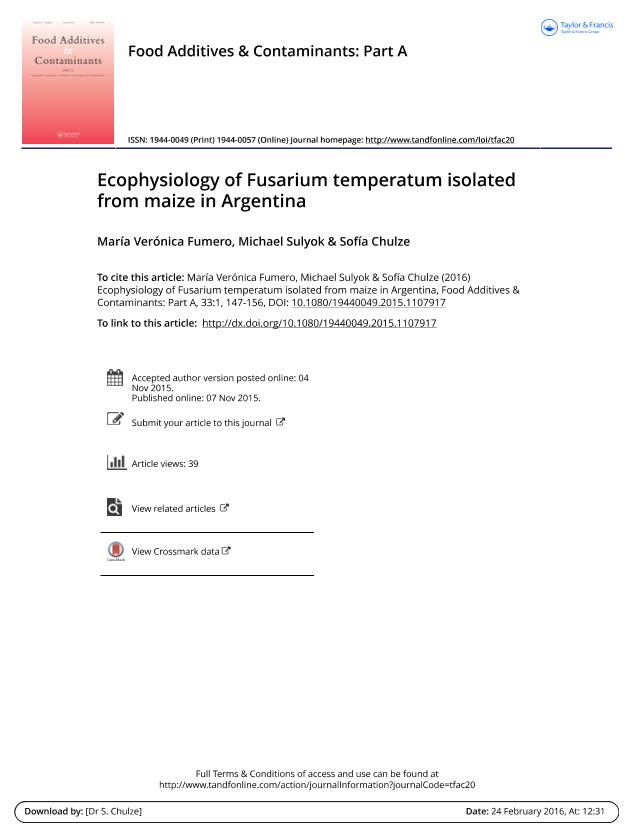Artículo
Ecophysiology of Fusarium temperatum isolated from maize in Argentina
Fecha de publicación:
09/2016
Editorial:
Taylor & Francis Ltd
Revista:
Food Additives and Contaminants
ISSN:
0265-203X
e-ISSN:
1944-0057
Idioma:
Inglés
Tipo de recurso:
Artículo publicado
Clasificación temática:
Resumen
The effect of water activity (aw = 0.95, 0.98 and 0.995), temperature (15, 25 and 30°C), incubation time (7, 14, 21 and 28 days), and their interactions on growth and moniliformin (MON), beauvericin (BEA), fusaproliferin (FUS) and fumonisin B1 (FB1) production by two strains of Fusarium temperatum isolated from Argentinean maize were determined in vitro on sterile layers of maize grains. The results showed that there was a wide range of conditions for growth and mycotoxins production by F. temperatum. Both strains were found to grow faster with increasing aw and at 30°C. In relation to mycotoxin production, the two strains produced more FUS than the other mycotoxins regardless of aw or temperature evaluated (maximum = 50 000 μg g−1). For FUS, MON and BEA, the maximum levels were observed at 0.98 aw and 30°C (50 000, 5000 and 2000 μg g−1 respectively). The lowest levels for these three mycotoxins were detected at 15°C and 0.95 aw (1700 and 100 μg g−1 for FUS and MON respectively), and at 0.98 aw (400 μg g−1 for BEA). The maximum levels of FB1 were produced at 15°C and 0.98 aw (1000 μg g−1). At all aw and temperatures combinations evaluated there was an increase in toxin concentrations with time incubation. The maximum levels were detected at 21 days. Statistical analyses of aw, temperature, incubation time, and the two-and three-way interactions between them showed significant effects on mycotoxins production by F. temperatum. For its versatility on growth and mycotoxin production, F. temperatum represents a toxicological risk for maize in the field and also during grain storage.
Palabras clave:
ECOPHYSIOLOGY
,
FUMONISIN
,
BEAUVERICIN
,
MAIZE
,
FUSAPROLIFERIN
Archivos asociados
Licencia
Identificadores
Colecciones
Articulos(CCT - CORDOBA)
Articulos de CTRO.CIENTIFICO TECNOL.CONICET - CORDOBA
Articulos de CTRO.CIENTIFICO TECNOL.CONICET - CORDOBA
Citación
Fumero, María Verónica; Sulyok, Michael; Chulze, Sofia Noemi; Ecophysiology of Fusarium temperatum isolated from maize in Argentina; Taylor & Francis Ltd; Food Additives and Contaminants; 33; 1; 9-2016; 147-156
Compartir
Altmétricas




